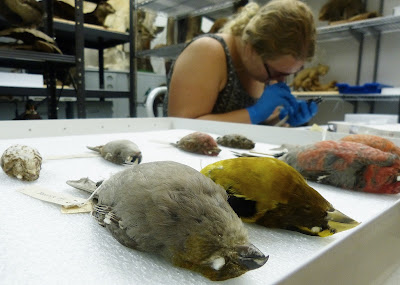Amusing Study Skins
This week the annual maintenance of all specimens took place. Working inside the collection storage room which is viewable to the public, we felt that we had become part of the animal displays that visitors routinely gawk at. A father held his toddler daughter up to the glass and pointed; a slightly older son stood at the door and squirmed in place all while his eyes held my gaze each time I looked up to the distraction.
 |
| Intern Norveig Olson assisted in the collection room by assessing many of our animal specimens, including bird study skins. |
A significant portion of maintenance involves standard cleaning of each object--vacuuming, or for more delicate specimens, gentle brushing or visual scrutinizing. We check for physical damage, pests, or improper labels and make improvements accordingly. The task, while in itself becomes rather dull after just a bit of time, is a good excuse to dive into unique corners of the collection.
This time around, we were quite amused during our examination of the study skin cabinets. The Museum's study skins, maintained largely for taxonomic purposes, number over 100 birds and small mammals. Each is labeled with a paper tag that includes important collection and preparation information, as well as some entertaining notes. In one instance, we found a yellow-bellied sapsucker described as being "extremely fat." A number of others were revealed to have been prepared prior to the establishment of the Museum in 1967. Next time we thoroughly evaluate our collection, I'm sure we'll find just as interesting information.
 |
| Above, a Yellow-bellied Sapsucker (Sphyrapicus varius) is labeled as "extremely fat." Below, we came across a White-crowned Sparrow (Zonotrichia leucophrys) which was prepared in 1960. |
